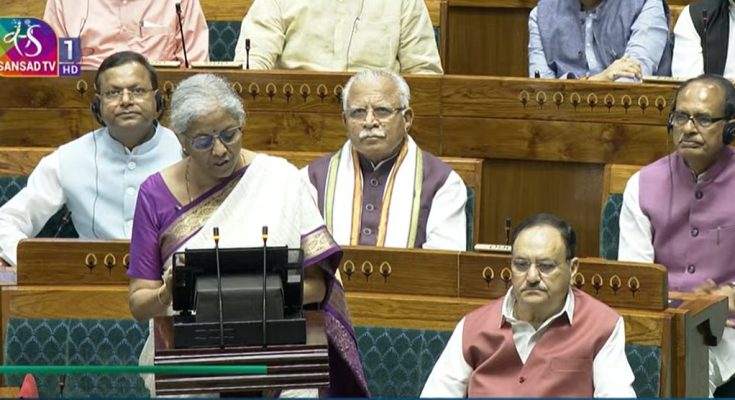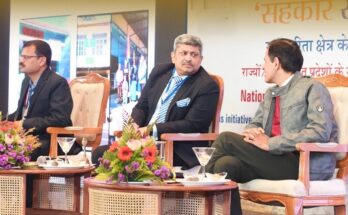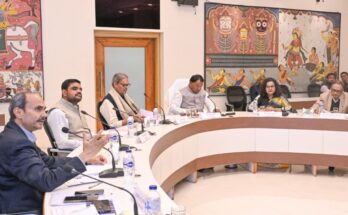By Dr Santosh Kumar Mohapatra
Disappointing Budget: Finance Minister Nirmala Sitharaman presented her seventh consecutive Budget in Parliament today – Tuesday, July 23. The budget is disappointing as it does not address the problem of poverty, hunger, inequality, unemployment, price hike and inflation. Rather government has indulging self-patting in controlling inflation. Inflation rate may decline but prices will not decline. The prices of essential commodities have doubled in the last few years.
The budget is parochial as it has tried to please Nitish Kumar and Chandrababu Naidu by providing more assistance to Andhra and Bihar. Flood assistance is given to Assam, but Odisha is neglected. ₹ 15,000 crore to be arranged for Andhra Pradesh for development of its capital, and four expressway and bridge projects worth ₹ 26,000 crores for Bihar.
There is talk of tourism package to Odisha, but nobody knows what will be its shape. Actually, poor states like Bihar, Assam, Odisha or any other states deserve extra package, but government has removed special category status. Other poor states should get special support.
The budget is contractionary as outlay increase is much less that the projected nominal GDP rise. Size of budget as percentage of GDP is much lower when copared developed countries. No proposal to generate tax resources by taxing rich and raising corporate tax or posing wealth tax.
The budget has given some tax relief to income taxpayers which actually an illusion. Salaried employees under new tax regime to save up ₹ 17, 500 annually in taxes, says Nirmala Sitharaman. The standard deduction has increased from ₹ 50, 000 crore to ₹ 75,000 crore which is inadequate when inflation is taken into consideration.
Finance Minister Nirmala Sitharaman announced the revised income tax slabs. The tax for a salary of up to 3 lakhs is nil, between ₹ 3 to 7 lakhs is 5 %, between ₹ 7 to 10 lakhs is 10%, between Rs 10 to 12 lakhs is 15%, between ₹ 12 to 15 lakhs is 20%, and over ₹ 15 lakhs is 30%.
In case of old tax regime, the tax for a salary of up to₹ 3 lakhs is nil, between ₹ 3 to 6 lakhs is 5 %, between ₹ 6 to 9 lakhs is 10%, between ₹ 9 to 12 lakhs is 15%, between ₹ 12 to 15 lakhs is 20%, and over Rs 15 lakhs is 30%.
Changes in tax slabs neither provide any concession to middle class people, nor try to tax people earning crores of rupees or having windfall gains like from IPL, advertisement. In case of change in tax slab, actually middle salary class are neglected.
There is no attempt to provide tax rebate for savings in new tax regime. Further, unlisted bonds, debentures, debt mutual funds, market-linked debentures to be taxed at slab rate, Short-term gains on some financial assets to attract 20%, It may encourage people save more in bank, insurance but overall financial savings will get beating and this detrimental to our economy.
It means savers are penalised for savings habit .and no attempt to made encourage financial savings which will weaken financial sector and government, corporates will struggle to borrow at cheaper rate.
It is publicised that capital expenditure is estimated to rise by 11% to ₹ 11.1 lakh crore (same was in Interim budget which reflect the government’s commitment to bolstering the nation’s infrastructure. But many roads especially in cities and villages are in decrepit stage. What is worrying is that a total of 431 infrastructure projects in India, with investments of over ₹ 150 crore each, experienced cost overruns of more than Rs 4.82 lakh crore in December 2023, this nullifies the benefits of rise in capital expenditure.
The fiscal deficit target for 2024-25 of 4.9 per cent of the Gross Domestic Product (GDP). This is 20 basis points lower than 5.1 per cent announced in the interim budget. Actually, it should be 3 to 3.5 percent. Whatever improvement achieved comparison to interim budget, it is due to exorbitant dividend from RBI.
A report by business standard on 30 January 2024 shows that Modi 2.0’ government’s spending on health education remains low. Expenditure on education as percentage of total expenditure declined from 3.33% in 2019-20 to 2.51 in 2023-24. Similarly, health expenditure declined from 2.36% to 1.97% in same period. Expenditure on Pension declined from 6.84% to 5.2% in the same period.
The government has failed to raise resources and control fiscal dripline. If the poverty rate at $3.65 a day (2017 PPP) is used then 46.54% Indians in 2021 are poor. The budget is disappointing, and no attempt is made to improve the standard of living by increasing expenditure on health and education. The dream of developed India is shattered.




